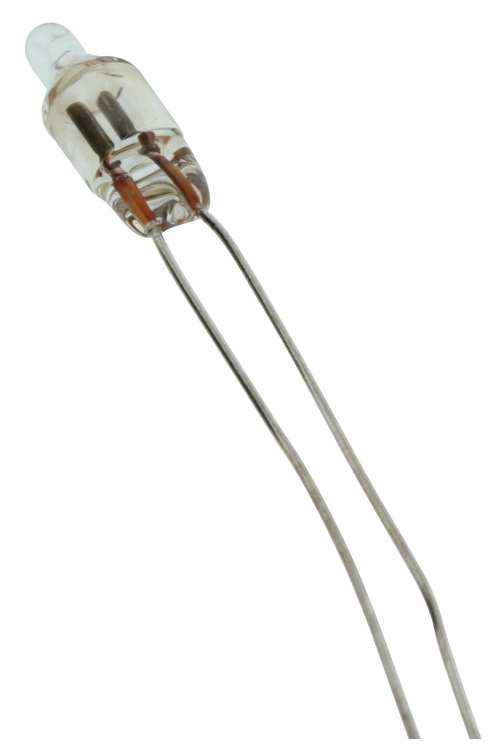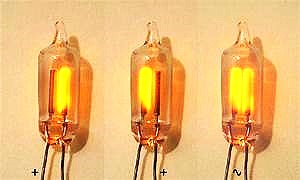Glowing Devils Eyes in the Audio Room
![[A neon schematic] [Neon schematic]](../jpg/neon_article1.jpg)
[ Home TNT-Audio | Staff & Contacts | HiFi Playground | Listening tests | DIY & Tweakings | Music & Books ]
![[A neon schematic] [Neon schematic]](../jpg/neon_article1.jpg)
Author: Mark Wheeler - TNT-Audio UK
Published: November, 2024
In the earliest days of CD players, being new technology, all sorts of ideas were put forward in the cause of better sound quality.
One such idea was that the illuminated track indicator display was causing distortion of some kind. Early CD players might have had flouroscan displays. These did need high voltages in order to operate. It is quite possible that these higher voltages, along with all the transport servo control stuff, would generate more electrical noise than audio circuit designers anticipated. Hence a designer tries their prototype with display on and display off and discovers that it sounds better with the display off. Sensing a USP, the designer and marketing people include an off switch for the flouroscan display. A reviewer reads this in the press release and indeed 'hears' the difference. Whether this is actually a difference in the production sample or merely confirmation bias is a moot point. The reviewer 'hears' the effect, publishes the effect and the effect is now part of established custom and practice.
Other manufacturers must now include this feature as a basic prerequisite of 'good' CD players. An audio myth is born and established. This is despite the fact that subsequent LED displays and backlit LCD displays use low voltages. This is also despite the fact that digital and analogue (and power supply) technology has subsequently improved to the extent that it is no longer likely to be an issue. Or is it?
![[LCD Display] [LCD Display]](../jpg/neon_article2.jpg)
It might not be an electrical issue but it could well be a continuing psychological issue. Merely removing the distraction of displays will increase concentration on the music and the sound quality. Your Old Scribe remembers back in the 1970s, a member of staff in a big Tottenham Court Road audio emporium suggesting that the massive illuminated VU meters on an imported behemoth of an amplifier were merely there to "Stop you noticing how sh*t they actually sound."
So there is still an argument for turning off displays to prevent distraction.
"What about the lights on mains distribution strips?" Challenge plebs, stage left, "Weren't they demonstrated to alter the mains waveform causing noise and distortion in amplifiers?"

Again, this is a real thing applying to past technology being repeated in modern contexts. Your Old Scribe was first told of this by the proprietor of a midlands Linn-Naim specialist. In those days two the best quality brands of 4-way and 6-way mains distribution strips (i.e. best sprung contacts) both had a neon indicator to show that they were live. A neon indicator lamp is a gas discharge device (like a neon sign) which has such a high internal resistance that in the mains context is practically an open circuit. However, it works by the rising voltage (of a half-cycle of the mains 50Hz or 60Hz sine waveform) exceeding the breakdown voltage of the neon gas. Then it glows, causing a voltage decrease, as the voltage increases, peaks and decreases. The neon's turn-off voltage is lower than it's turn-on voltage, but the measured AC voltage will not change under such a tiny load though. The neon does need a series ballast resistor to prevent arcing, further reducing any effect it may have on the mains supply. Neon lamps have also been used to protect RF receivers from voltage spikes with the lamp connected between live and ground (always on). If neon lamps generated RF, this would never have succeeded.

However, the electrical symbol for a neon lamp gives us one clue. The physical resemblance to a spark gap transmitter offers us another clue to the idea that neon lamps are noisy. Tests show that neon lamps do generate more noise than a resistor. That 'scope trace' I was shown had no calibration. Neon lamps actually generate far less noise than a typical silicon bridge rectifier. The combination of that ballast resistor and the neon acting across the load of the amplifier transformer, turntable motor windings and motor phase-shift capacitor might theoretically create conditions for a Pearson-Anson oscillator but (according to t'interweb) no one has ever presented evidence of any such occurrence. However, the neon rise time and operating point are affected by light levels. So the mains strip under the audio shelves may flicker differently and/or intermittently when light levels are really low. This will add perceptual noise to our brains, causing distraction, however unconscious.
Your Old Scribe has to confess to buying two identical MK mains strips back in the 1980s and removing the neon from one. Your Old Scribe thought (note 'thought') that there was a difference and used the lamp-less strip for the audio system until a dedicated mains spur was installed. Just removing visual distractions of any kind will increase concentration on the music.
Measurements of early generation energy saving bulbs, the curly fluorescent type, indicate far more high frequency and RF radiation than modern LED displays and LED domestic lighting (Healthy Building Science, 2024). Old fashioned dimmer switches could be so noisy that their electro-mechanical effect was audible across the room. Even conventional incandescent bulbs can radiate more interference or inject more noise than modern LED's. However, many people still use incandescent bulbs as voltage droppers on their turntable motors without hearing a detrimental effect.
![[Data analysis] [Data analysis]](../jpg/neon_article6.jpg)
![[Data analysis] [Data analysis]](../jpg/neon_article7.jpg)
Stop worrying, it'll distract you from the music.
Turn off distractions like phones and tablets.
Put a vinyl LP on the turntable (it is the healthiest recorded music format), turn the volume up to the sweet spot and just listen.
DISCLAIMER. TNT-Audio is neither a shop, nor a HiFi company or a repair laboratory for HiFi components. We don't sell anything. It is a 100% independent magazine that neither accepts advertising from companies nor requires readers to register or pay for subscriptions. If you wish, you can support our independent reviews via a PayPal donation. After publication of reviews, the authors do not retain samples other than on long-term loan for further evaluation or comparison with later-received gear. Hence, all contents are written free of any “editorial” or “advertising” influence, and all reviews in this publication, positive or negative, reflect the independent opinions of their respective authors. TNT-Audio will publish all manufacturer responses, subject to the reviewer's right to reply in turn.
Copyright © 2024 Mark Wheeler - mark@tnt-audio.com- www.tnt-audio.com
[ Home TNT-Audio | Staff & Contacts | HiFi Playground | Listening tests | DIY & Tweakings | Music & Books ]